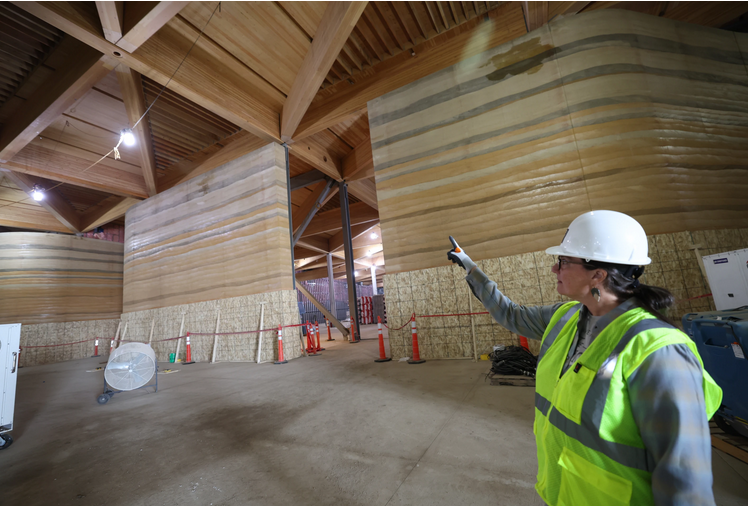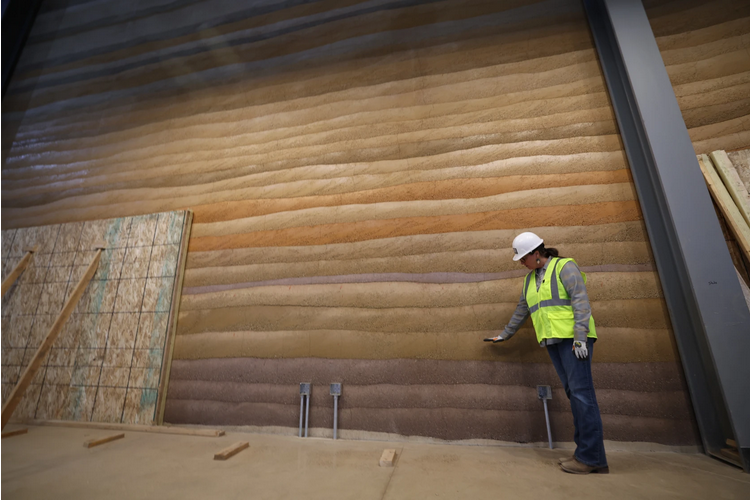The design concept for the Theodore Roosevelt Presidential Library in Medora, North Dakota is a “journey through a preserved landscape … a continuum between past and present,” according to Snøhetta, which was commissioned for the design. “Our design … is informed by the president’s personal reflections on the landscape, his commitment to environmental stewardship, and the periods of quiet introspection and civic engagement that marked his life.”
 As the exterior of the library nears completion the architect’s visionary concept is coming to life, highlighted by a towering rammed-earth wall, which reaches 30 feet in the air toward a sprawling ceiling of exposed timber panels and beams, and stretches 240 feet across. Bearing a resemblance to the sedimentary striations of North Dakota’s Badlands, its rough-hewn surface is pocked and porous, with uneven layers, and an earthy palate of sand, stone, mud and dust.
As the exterior of the library nears completion the architect’s visionary concept is coming to life, highlighted by a towering rammed-earth wall, which reaches 30 feet in the air toward a sprawling ceiling of exposed timber panels and beams, and stretches 240 feet across. Bearing a resemblance to the sedimentary striations of North Dakota’s Badlands, its rough-hewn surface is pocked and porous, with uneven layers, and an earthy palate of sand, stone, mud and dust.
The rammed-earth technique has gained popularity due to its environmentally-friendly process and energy efficient qualities. A lot of trial and error went into determining the particular formula for the wall’s earthen mixture.
 Forms were placed first, into which the soil mixture would be poured. Rebar was run down the middle to reinforce the wall. Then, the soil and gravel was mixed with 10% cement, with varying pigment amounts to achieve the colored layers, as well as a small amount of water to create the particular rammed-earth formula.
Forms were placed first, into which the soil mixture would be poured. Rebar was run down the middle to reinforce the wall. Then, the soil and gravel was mixed with 10% cement, with varying pigment amounts to achieve the colored layers, as well as a small amount of water to create the particular rammed-earth formula.
After the appropriate mixture was achieved, it was fed from an auger-style mixer to a truck-mounted conveyor designed to place concrete and other materials in hard-to-reach or elevated locations. From there, the mixture was poured into the forms. For safety reasons, the team worked on four feet of wall at a time. Every layer that you see was placed and compacted individually. First it’s placed in roughly 12-inch loose layers of the consistency of a good road base. After that the mixture was tightly compacted, or rammed, into the final eight-inch layer.
 The construction of the library’s rammed-earth walls took a 15-man crew just over three months to complete. Two million pounds of material were used in the process.
The construction of the library’s rammed-earth walls took a 15-man crew just over three months to complete. Two million pounds of material were used in the process.
The wall is not a structural element of the building, but it will help with the energy usage, retaining heat and keeping the space cool in the summer, and helping with humidity and moisture in the air.
You can read the original article at www.inforum.com
